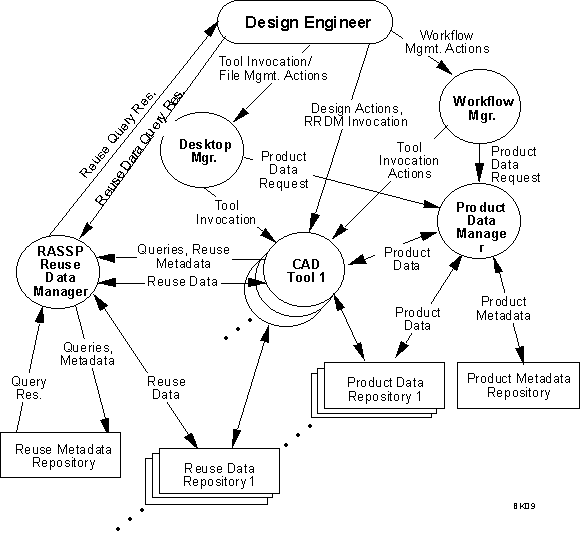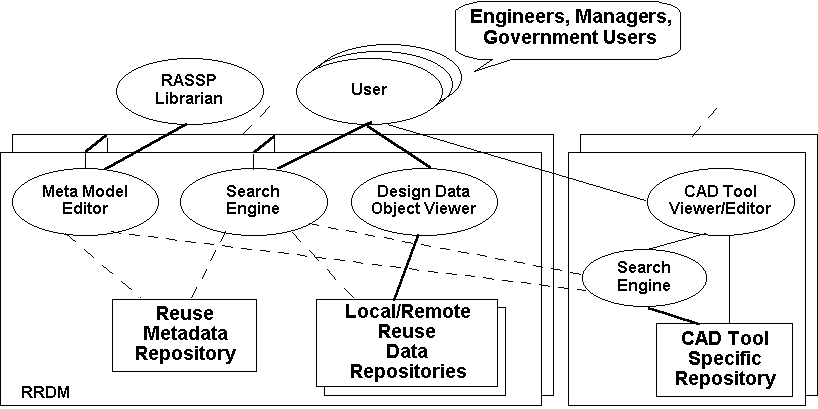Next: 3 The RASSP Authorization Model Up: Appnotes Index Previous: 1 Introduction
![]()
![]()
![]()
![]()
Next: 3 The RASSP Authorization Model
Up: Appnotes Index
Previous: 1 Introduction
Figure 2 - 1 shows the data flow architecture of the RASSP enterprise system. A design engineer interacts with a workflow manager to perform various predefined process steps. On execution of a particular process step, the workflow manager may invoke the appropriate CAD tool for the activity, opening the requisite product data files and making them available in the designer's workspace. The workflow manager interacts transparently with the product data manager on behalf of the user to open, close, save and configuration manage the product data files. The user may also interact directly with the desktop manager to invoke tools outside of the workflow environment, as needed
Once a CAD tool has been invoked, the designer interacts with the tool in its native environment to perform a design or analysis activity. He or she may invoke the RRDM through the CAD tool environment or directly. The RRDM may receive reusable design knowledge from the CAD tool, or meta-data only in cases where the design is managed in place. Additional meta-data is solicited from the environment as well as from the designer through the use of domain-specific templates. Both the meta-data and design knowledge (where applicable) are stored in the local design knowledge repository. The workflow manager for the RASSP Enterprise System is implemented through Intergraph Corporation's Design Methodology Manager (DMM), and the product data manager is implemented by the Intergraph Asset information Manager (AIM). Additional information on the RASSP Enterprise System is provided in Enterprise Application Note
The architecture of the RASSP Reuse Data Manager (RRDM) and its relationship to users and other system resources is detailed in Figure 2- 2. The RRDM consists of a client browser, a "perspectives" application server (including the search and vocabulary mapping engines), and multiple source data repositories. A designer looking for reusable design knowledge browses the hierarchy and identifies a potential source for designs of interest. Then, through a custom view of the common vocabulary, the user may specify attributes of the candidate design(s) he or she is interested in. Queries may include arithmetic expressions, logical expressions, attributes of related classes, and constraints on any of the attributes, as appropriate. Mapping algorithms that account for a variety of data inconsistencies, differences in precision, translation of units of measure, and other distinctions among terms across repositories are resolved to the user's customized vocabulary and display requirements. The search of available (and optionally selected) source repositories is performed in parallel, with meta-data for all results displayed through the client browser. Depending on the number and nature of the results returned, he or she may further refine the search by specifying additional attributes and/or more restrictive criteria. Objects of interest may be selected and the corresponding designs (e.g., schematics, drawings, models) displayed in their native tool environments given that appropriate resources are available to the user.
A prototype of the RASSP Reuse Data Manager (RRDM) was demonstrated in April 1998, providing access to multiple, distributed repositories of VHDL models. The key capabilities featured at this RASSP demonstration are summarized below.
Planned Enhancements
A number of additional capabilities are planned for the commercial product and subsequent releases by Sandpiper Software, Inc. These include:
Operational support tools and utilities (e.g., ontology generation and development, data migration, system administration) are also being developed independently by Sandpiper Software to support the commercial information broker product.
2.0 Architecture of the RASSP Enterprise System


![]()
![]()
![]()
![]()
Next: 3 The RASSP Authorization Model
Up: Appnotes Index
Previous: 1 Introduction